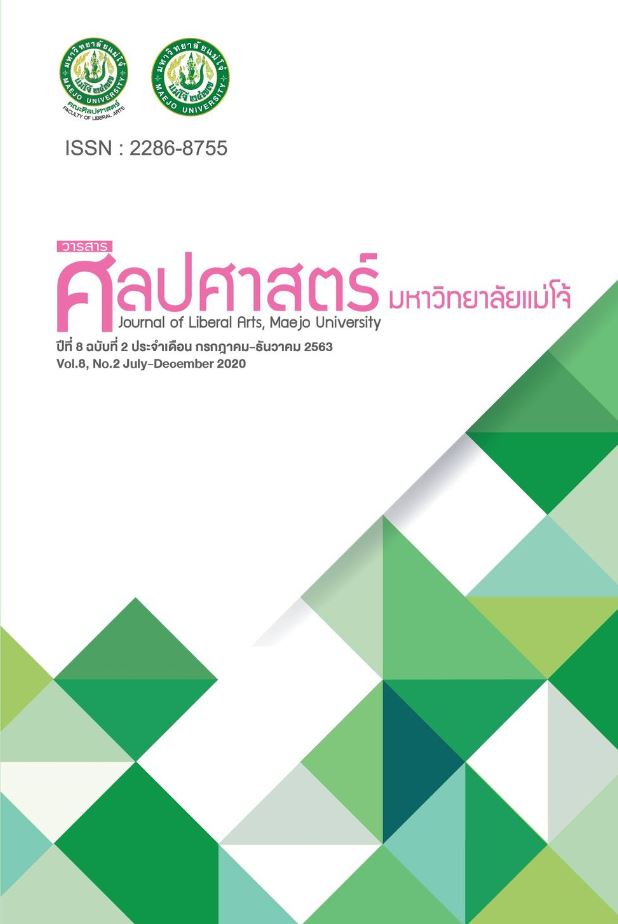An Inter-Modal Construction of Ideational Meaning Analysis and Foucault’s Repressive Hypothesis: A Comparison between the Film and Novel Call Me by Your Name
Main Article Content
Abstract
This study aimed to employ the framework of inter-modal construction of ideational meaning, as proposed by Unsworth (2006), to compare the instantiations across two different modes of the story ‘Call Me by Your Name’, the novel and its film. The story follows a relationship between two men during a period and culture of repressiveness toward homosexuality. Therefore, Foucault’s repressive hypothesis (1978) is used to interpret the homosexual practices in the story. Three main forms of ideational meaning were found from the comparative analysis: concurrence, complementarity, and connection. These forms of ideational meaning, coupled with Foucault’s repressive hypothesis, help to profoundly explain the homosexual practices in the story, which are thematized into three aspects: fantasy, secrecy, and repression. ‘Call Me by Your Name’ is a contemporary medium conveying the repressed sexual sentiments that may occur in the context of homosexuality.
Article Details
References
Acimen, A. (2007). Call Me by Your Name. London: Atlantic Books.
Acimen, A. (2007). Call Me by Your Name. (Keerote, A., Trans.). Bangkok: Classact Publishing.
Foucault, M. (1978). The History of Sexuality (Vol.1: An introduction) (Hurley, R., Trans). New York: Pantheon Books.
Guadagnino, L., & Ivory, J. (2017). Call Me by Your Name (Motion Picture). Los Angeles: Sony
Pictures Classics & Roma: Warner Bros Pictures.
Jewitt, C. (2002). The move from page to screen: The multimodal reshaping of school English.
Visual Communication, 1(2), 171-196.
Kress, G. (2000). Multimodality. In Cope, B. & Kalantzis, M. (Eds.), Multiliteracies: Literacy Learning and the Design of Social Futures (pp.182-202). Melbourne: Macmillan.
Lim, V. (2004). Developing an integrative multi-semiotic model. In K. O'Halloran (Ed.), Multimodal Discourse Analysis: Systemic Functional Perspectives (pp. 220-246). London and New York: Continuum.
Lemke, J. (2002). Travels in hypermodality. Visual Communication, 1(3), 299-325.
Martinec, R. & Salway, A. (2005). A system for image-text relations in new (and old) media. Visual
Communication, 4(3), 337-371.
Menta, A. (2017). Sex and the single boy. Newsweek, 169(23), 46-47.
Miller, J. (2018). Correspondence: Science and equal rights. The Gay & Lesbian Review worldwide, 25(3), 6.
Sorrentino, R., & Turban, J. (2018). Call Me by Your Name: Not pedophilia, still problematic. Psychiatric Time, 35(9), 16A-16F.
Stam, R. (2005). Introduction: The theory and practice of adaptation. In Stam, R. & Raengo, A. Literature and Film: A Guide to the Theory and Practice of Film Adaptation (pp. 1-53). Malden: Blackwell publishing.
Unsworth, L. (2006). Towards a metalanguage for multiliteracies education: Describing the meaning-making resources of language-image interaction. English Teaching: Practice and Critique, 5(1), 55-76.
Call Me by Your Name Awards. (2018). Retrieved December 25,2018, from https://www.imdb.com/ title/tt5726616/awards?ref_=tt_awd.

